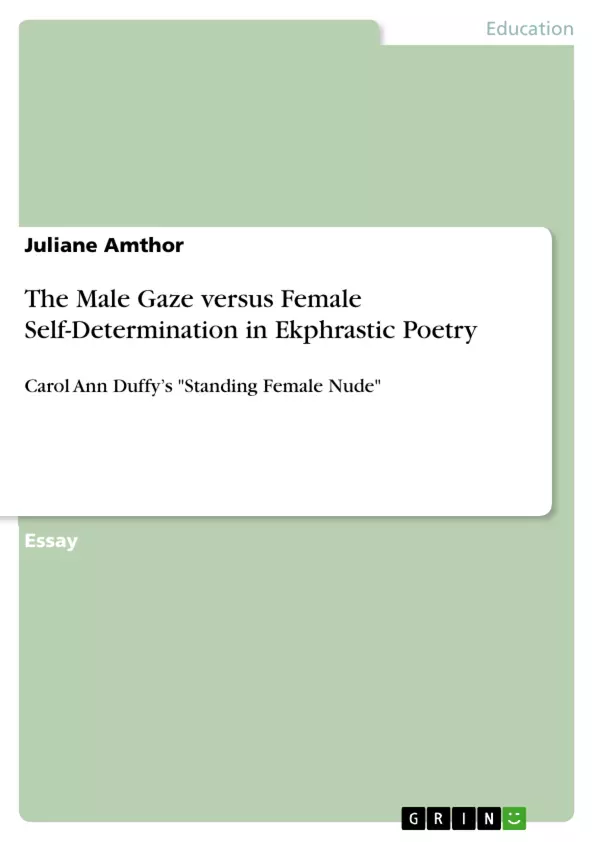This essay examines the confrontation of the male gaze with female self-determination in ekphrastic poetry, using the poem Standing Female Nude by Carol Ann Duffy as an example.
The main aim of the essay is to show how ekphrasis and its specific features serve as a space in which gender conflicts are debated in the realm of aesthetics and how the emergence of a “distinctive female ekphrastic mode” (Kennedy 2012: 90) led to a shift from masculine dominance towards female power in the genre. In a first step, a definition of ekphrasis will be given and we will argue the case for why certain characteristics make ekphrasis particularly suitable for exhibiting the male gaze.
Subsequently, in a second step, we will demonstrate to what extent female writers have modified the conventions of ekphrasis and challenged its traditional gender relations to suit their own need for self-determination. Carol Ann Duffy’s poem Standing Female Nude (1985) will serve as an example for feminist ekphrasis.
Table of Contents
- Introduction
- 1. Ekphrasis as the Epitome of Male Power in Aesthetics
- 1.1 Definition of Ekphrasis
- 1.2 The Male Gaze in Aesthetics and Ekphrasis
- 2. Female Modification of the Genre on the Example of Carol Ann Duffy's Standing Female Nude (1985)
- 2.1 The Voice of Female Authors of Ekphrasis
- 2.2 Still Ekphrasis? - Contesting Traditional Male Conventions
- 2.3 The Transformation of the Ekphrastic Image : From Object to Subject
- 3. Conclusion
Objectives and Key Themes
This essay aims to explore the relationship between ekphrasis and gender, specifically focusing on how the genre has traditionally been a space for the male gaze and how female writers have challenged and redefined this dynamic. It will investigate how ekphrasis, with its inherent power dynamics, has been used to reinforce traditional gender roles and how female authors have carved out a distinct "female ekphrastic mode" to express their own experiences and perspectives.
- The male gaze in aesthetics and its impact on ekphrasis
- The historical dominance of male voices in ekphrastic poetry
- The emergence of a "distinctive female ekphrastic mode"
- The role of Carol Ann Duffy's Standing Female Nude (1985) as an example of feminist ekphrasis
- The challenges and opportunities presented by ekphrasis for female self-determination
Chapter Summaries
The essay begins by defining ekphrasis and outlining how the genre has traditionally functioned as a tool for the male gaze. It examines how the visual and verbal mediums have been employed to establish a power dynamic in which the male author controls and objectifies the female subject.
The second chapter delves into the feminist reinterpretation of ekphrasis. It discusses the rise of female voices in the genre and how these authors have challenged the traditional male gaze. The poem Standing Female Nude by Carol Ann Duffy serves as an example of feminist ekphrasis, demonstrating how female writers use the genre to reclaim their agency and challenge traditional representations of women.
Keywords
The primary keywords and themes of this essay are: ekphrasis, male gaze, female self-determination, feminist ekphrasis, gender, power dynamics, visual and verbal representation, and Carol Ann Duffy's Standing Female Nude. These terms capture the core concepts explored in the essay, focusing on the historical and contemporary perspectives of gender representation in the ekphrastic tradition.
- Quote paper
- Juliane Amthor (Author), 2015, The Male Gaze versus Female Self-Determination in Ekphrastic Poetry, Munich, GRIN Verlag, https://www.hausarbeiten.de/document/307706


